[current_post_breadcrumbs]
Princess cut diamond engagement rings in Canada
Get the most beautiful princess cut diamond and the best value
[current_post_author_name]
[current_post_mdate]
If you want to buy a Princess cut diamond engagement ring in Canada and want to make sure you get the most beautiful diamond and the best value, you’re in the right place.
- On this page we’re going to look at:
- Why Princess cut engagement rings make a great choice
- What you need to be careful about when buying a princess cut diamond
- A Princess cut diamond buying guide to make sure you get the best stone possible
- Where to buy to get the best value possible

Princess cut diamonds sparkle brilliantly
The Princess cut diamond shape was originally developed in the early ’80s as jewelers began to use laser and computer modelling to understand how light was reflected by a diamond.
By ensuring that they reflected as much light as possible, they could ensure that the diamond would sparkle brilliantly.

The bonus of this is that the ‘fire’ (coloured sparkle) and scintillation (black and white sparkle) in princess cut diamonds can help hide flaws in the stone itself. Minor inclusions and lower colour gradings will be hidden by the sparkle, which is not the case for all diamond shapes.
For shapes with less sparkle e.g. the emerald cut, you need to go for a higher quality, and therefore more expensive stone, as any imperfections in clarity or colour are much more likely to be visible.
Princess cut diamonds are well-priced
Princess cut diamonds are the second most popular shape for engagement rings in Canada after round diamonds, which means there’s a large selection of stones available to choose from.
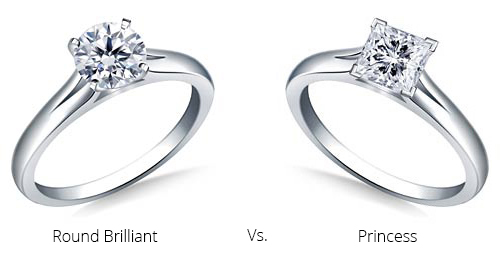
The table below shows the price difference at one of my recommended retailers between a round brilliant diamond, the most common shape and an princess cut diamond of the same size and quality:
- 1 carat
- Color F
- Clarity VS1
Here’s how they compare:
| SHAPE | PRICE (CAD) | DIFFERENCE (CAD) | DIFFERENCE (%) |
|---|---|---|---|
| Princess cut | 5,718 | ||
| Round Brilliant | 7,168 | +1,450 | +25.4% |
That’s a huge difference, especially considering that the Princess cut is considered to have ‘optical performance’ and sparkle very close to the round brilliant.
Although the exact difference will depend on the specs of the stone that you’re looking at, you can typically expect to save 25-33% on the price of a diamond by buying a princess cut than round brilliant of equivalent size and quality.
You can see today’s prices for princess cuts and round brilliant diamonds at my recommended retailer here.
Why princess cut diamonds are less expensive than round diamonds
A major factor of why princess cuts are less expensive than round diamonds are because there is significantly less wastage of the original rough diamond when creating a princess cut diamond.
An uncut, rough diamond crystal in their natural state is an ‘octohedron’ shape:
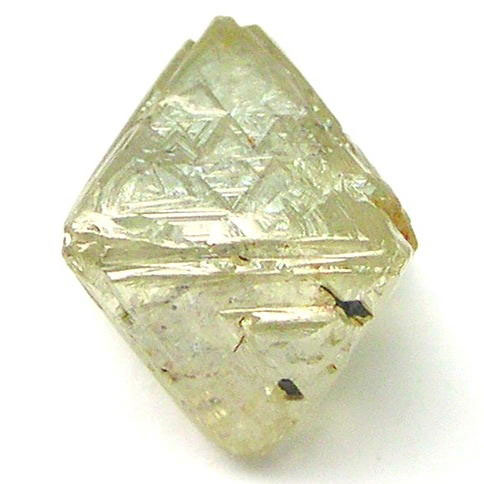
Diamond cutters try to ensure that as much of the original diamond ‘rough’ is used as possible, with little wasted.
Reducing the amount of the rough diamond wasted means that a larger finished stone can be produced, which allows them to sell the diamond for more money.
The Princess cut’s shape is very similar to one half of the rough diamond, which means that diamond cutters don’t have to lose a lot of the raw material when creating the final diamond mirror the rough cut stone’s angles very closely, so the cutters don’t need to trim away large areas like they do with the round brilliant. The round brilliant loses large portions of the corners of the rough diamond as the cutter trims it to the round shape.
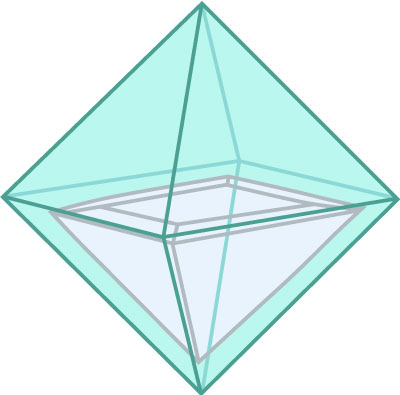
The Princess cut’s shape mirror the rough cut stone’s angles very closely, so the cutters don’t need to trim away large areas like they do with the round brilliant. The round brilliant loses large portions of the corners of the rough diamond as the cutter trims it to the round shape.
While a Princess cut diamond may only lose 10-20% or the rough diamond, a round brilliant may lose up to 50%. So, for a given finished size, a diamond cutter has to start off with a much larger, and more expensive, uncut diamond crystal.
International Princess cut guides
Each country has its own retailers we’ve therefore created individual princess cut guides for different countries. If you live outside of Canada and have found yourself on this page, click below to access your local guide:
Where to buy princess cut engagement rings in Canada

When buying any diamond, there are basically three places to consider:
– Large, chain stores
– Smaller, more upmarket jewellers
– Online stores
Where you choose to buy your diamond will make the biggest difference on how much value you get with your purchase. If you choose the wrong place, you could end up spending more that you need to and get a lower quality stone, as we’ll see.
In this section, we’ll take a look at the selection and prices for princess cut diamonds couple of Canadian jewellers stack up.
Buying a princess cut diamond ring from Peoples
Peoples jewellers is probably the largest jewellery chain in Canada with over 150 locations. They’re a well-known brand and are part of one of the largest jewllery retailers in the world, Signet.
Looking on the Peoples website, they have a 1 carat princess cut diamond engagement ring priced at C$6,999. The centre diamond for this ring has the following specs:
- Carat weight: 1 carat
- Colour grade: J
- Clarity grade: I1 (Included 1)

$6,999 is a significant budget for a diamond ring, and if you are spending that much money, then you should expect to get a diamond that looks great.
However, you don’t need to spend that much to get a diamond with the same specs as the stone above. In fact, by being smart with where you buy, you can pay less than half that amount for a diamond with the exact same specifications.
We can find a diamond with identical specifications (1 carat, J colour, I1 clarity) through one of my recommended retailers for C$3,042:
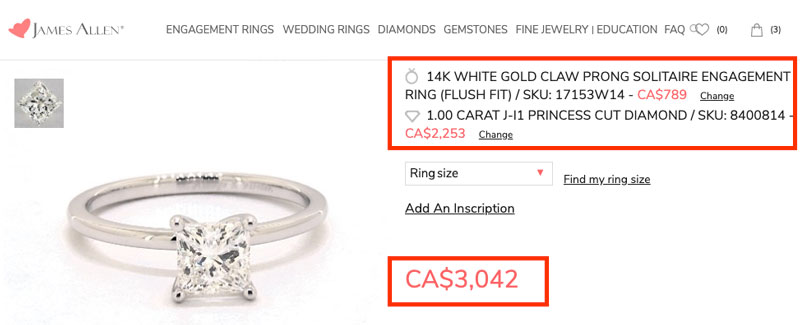
This is a 1 carat diamond with the exact same colour and clarity as the diamond from Peoples, but priced nearly C$4,000 lower. Check out today’s prices here.
It should be noted that this is a US-based retailer, which means that taxes in your province will need to be added to this. I have a whole blog on importing a diamond into Canada with the specific taxes listed for each province, but the short version is that the highest HST that could be added is 13% on top of the sale price. 13% of this ringwould add $395 to this ring, bringing the total to $3,437:
| RETAILER | PRICE (CAD) | DIFFERENCE (CAD) | DIFFERENCE (%) |
|---|---|---|---|
| James Allen | $3,437 | ||
| Peoples | 6,999 | +$3,562 | +103% |
$3,437 is a huge $3,562 lower than the Peoples price, or less than half the price:

But! Neither of these diamonds is worth buying
Something to know when looking at this comparison is that this is not a diamond that I would recommend you buy, either from Peoples or my recommended retailer – it has too many compromises in its colour and clarity.
For princess cut diamonds, I recommend that you choose a stone that has been graded G colour or above:
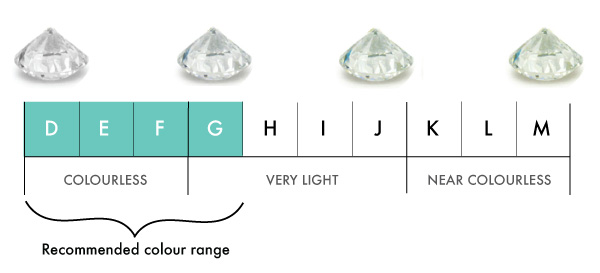
Going lower than this means that warmer / yellow tones may be able to be picked up, which many people find undesirable.
This stone, however, has been graded J colour:
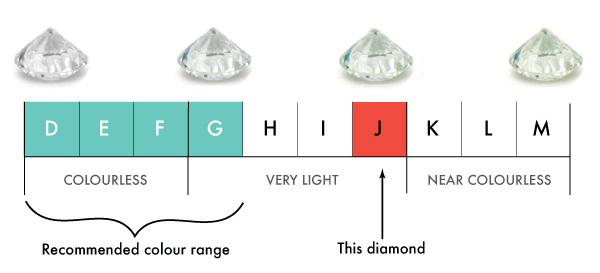
This means that it is very likely that some yellow would be visible in the diamond.
The exception to this would be if the diamond was going to be set into a yellow gold setting, in which case J would be an acceptable colour.
Another factor that rules out this diamond is the clarity grade. With a princess cut diamond, I recommend that people choose either a VS2 or a VS1 clarity. This ensures that the diamond does not have any visible inclusions but also that you aren’t paying extra for higher clarity grades which don’t make a difference to what the diamond actually looks like.

The diamonds above have both been graded as ‘Included 1’, which sits here on the clarity scale:

The definition of an I1 diamond includes:
“Included diamonds have inclusions that are usually visible without magnification or have inclusions that threaten the durability of the stone.
Inclusions in I1 diamonds often are seen by the unaided eye. I2 inclusions are easily seen”
While the image on the Peoples website looks like a nice clear diamond, this is just a reference image.
The picture below shows what a typical I1 clarity diamond can actually look like, with a large black inclusion under the table of the stone.

There is a major inclusion which would be easily visible to the naked eye.
So, with either of the diamonds above, it’s likely that it will look yellower than you would like and would have a visible black inclusion. Not great.
Get a better princess cut for less money
My usual recommendation for a princess cut diamond would be G colour and VS2 clarity, which will mean that it looks perfectly white once set into a ring setting and will be ‘eye clean’ ie. there are no ugly inclusions.
The price of a 1 carat diamond that fits these specs is C$5,310:
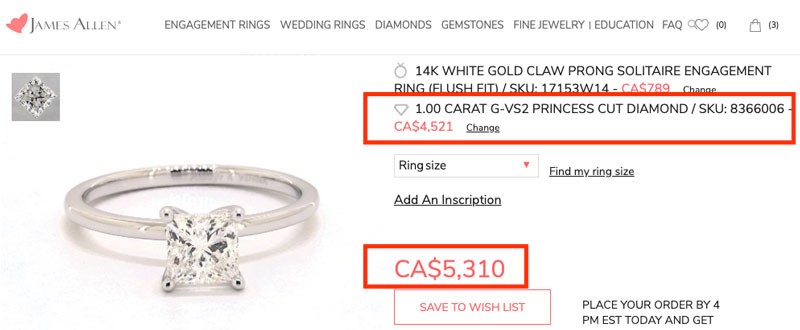
You can see this diamond here to confirm the price
Adding the maximum 13% HST which would be due when importing into Canada and the total is C$6,000.
| RETAILER | PRICE (CAD) | DIFFERENCE (CAD) | DIFFERENCE (%) |
|---|---|---|---|
| James Allen G colour, Vs2 diamond | $6,000 | ||
| Peoples J colour, I1 diamond | 6,999 | +$999 | +16% |
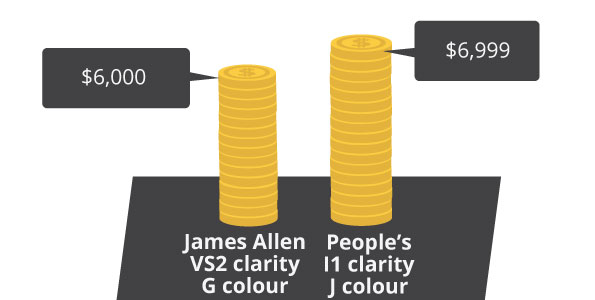
So, for around C$1,000 less, you can get a significantly higher quality diamond, which will look perfectly white and have no visible inclusions.
Buying a princess cut diamond ring from Maison Birks
Looking at an alternative from a huge chain, Maison Birks is a luxury jeweller with 24 stores across Canada. Still a chain, but one that has built an impressive brand and reputation based on the quality of its service and its merchandise.
Maison Birks has doesn’t offer a huge selection of princess cut diamond rings on their website, but they do offer a 1/2 carat solitaire princess cut engagement ring.
The stats of the diamond were:
- Carat weight: 0.5 carats
- Colour grade: H
- Clarity grade: VS2
This diamond’s colour grade is a little lower than I would usually recommend, but overall it is likely that this would be an acceptable diamond.
The diamond is set into an 18k white gold solitaire setting, and is priced at C$3,925:
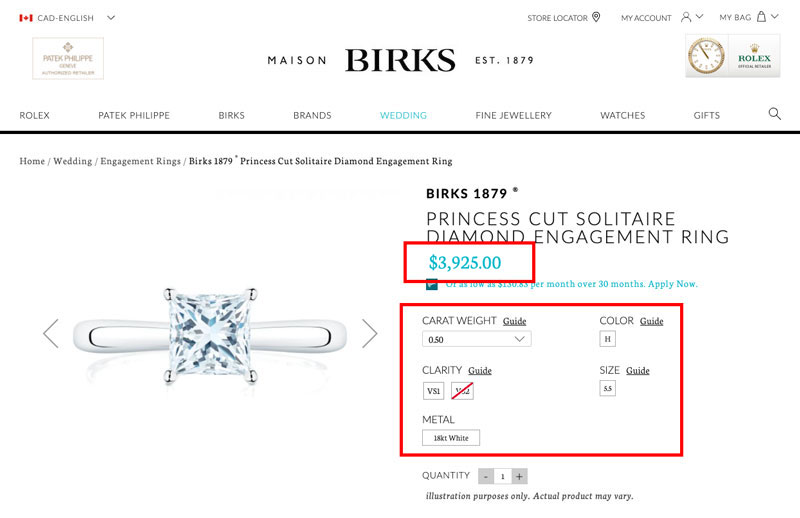
Finding a similarly specified diamond online to compare this one to is very easy.
At another of my recommended retailers, a diamond with the same colour (H) and clarity (VS1) is just C$1,517:
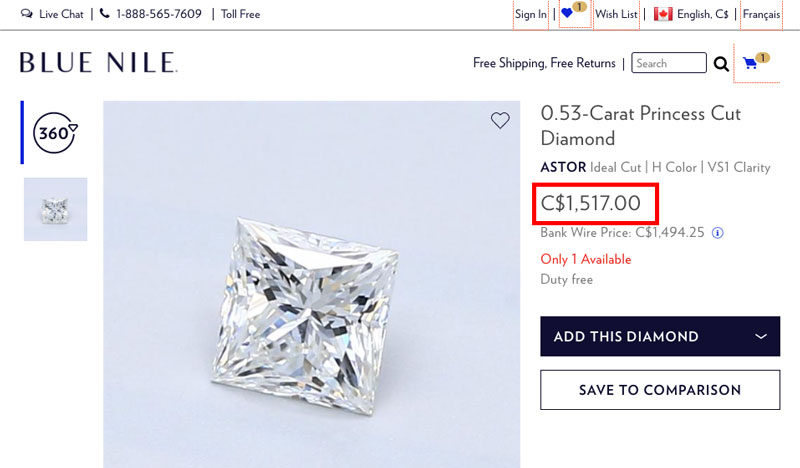
This is actually one of Blue Nile’s signature ‘Astor’ diamonds, which have a dual certification to verify that they sparkle incredibly well.
When an $18k white gold solitaire setting is added, the price increases to $2,137:

With the maximum 13% HST added to this, the total is C$2,414:
| RETAILER | PRICE (CAD) | DIFFERENCE (CAD) | DIFFERENCE (%) |
|---|---|---|---|
| Blue Nile | 2,414 | ||
| Maison Birks | 3,925 | +1,511 | +62% |
Again, the difference between the price of the Canadian retailer and the price of importing a diamond from the US is significant:
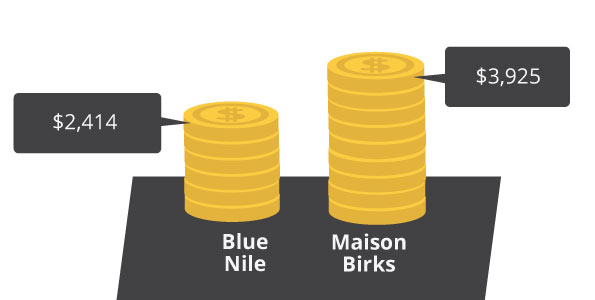
If you are looking to maximise your value when buying your ring and don’t want to pay more than you need to, then it makes sense to check out US online retailers.
My recommendation is James Allen which offers high quality imagery of every princess cut diamond so you can see what you’re buying and fair prices to ensure that you get real value.
How to select the most beautiful princess cut diamond for your ring
Not all diamonds are created equal, so this section will talk you through the 4Cs in relation to the Princess cut so that you can make sure you get an incredible stone.
We’re going to look at:
- Cut
- Color
- Clarity
- Carat
We’ll also look at a couple of other factors that are important to ensure that you get the most beautiful princess cut for your budget:
- Certification
- Choice

Princess cut diamond cut quality
When we are talking about ‘cut’ with a diamond, it isn’t the shape that it has been cut into, but rather a measurement of the stone’s proportions, which affects how much light it will reflect and therefore how much it will sparkle.
For example, this diamond has been cut to be very shallow, which means that light passes through the stone and is lost:
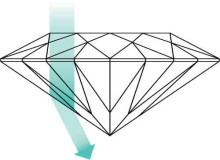
This diamond, however, has been cut with good proportions which means that light is reflected off the bottom facets of the diamond and back up through the top table as brilliant sparkle:

Diamond cut is the most important of the 4Cs, as it is the factor that has the biggest effect on how much light is returned to your eye.
Round diamonds use a grading scale for cut quality, just like the scale used for colour and clarity, which makes it easy to choose a good diamond from a bad one.
Unfortunately there’s no equivalent GIA grading scale of cut for Princess cut diamonds, which makes judging a stone’s cut quality more difficult, but not impossible. A lot of retailers do include a cut quality for princess cut diamonds in their search tools, but these are based on their own opinions, rather than an independent grading report.
There are two ratios that you can look at to make sure that you choose a princess cut diamond with good proportions
Princess cut diamond depth percentage
Depth percentage is the ratio of the depth to the width of the stone:
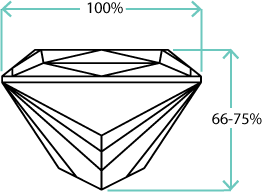
This is important because if the diamond is too shallow, light will pass straight through and be lost. If it is too tall it will reflect light back at the wrong angle. Both of which mean that the stone won’t sparkle well.
My recommendation for the best princess cut depth percentages are below:
| EXCELLENT | VERY GOOD | GOOD |
|---|---|---|
| 66% – 75% | 64% – 76.5% | 62% – 78% |
Aim for a depth % in the ‘excellent’ range if possible, to ensure that your princess cut diamond sparkles brilliantly and looks its carat weight.
You can select depth % in the ‘advanced options’ of most online retailers diamond search tools:

Princess cut diamond table percentage
The ‘table’ of a diamond is the large, flat area on the top of the stone.
The size of the table is important because it’s where the majority of light enters the stone and it needs to be just right to allow maximum sparkle. A larger table and more light is not always better.

Again, you should be able to select table % on most online retailers search tools and a table percentage within the excellent range below will ensure your princess cut delivers the best sparkle:
| EXCELLENT | VERY GOOD | GOOD |
|---|---|---|
| 66% – 75% | 64% – 77% | 62% – 79% |
Princess Cut Length / Width Ratio
A perfectly symmetrical princess cut diamond would have a length:width ratio of 1:1 – ie. it’s a perfect square.
However, some Princess cut diamonds can have a L/W ratio as high as 1: 1.10, which will actually be noticeably rectangular when worn.
My recommendation is to go for a length : width ratio of 1:1.05 at the most.

Princes cut Polish
Diamond polish is a measure of the tiny imperfections that can get introduced to a diamond in the final finishing stages of the cutting process. They are usually microscopic marks, like the ‘abrasions’ below which are invisible to the naked eye.

Polish shouldn’t be a major factor in choosing your diamond, but it can be a way of choosing between two stones that are other wise very similar. Aim for ‘Excellent’ or ‘Very Good’ to ensure that there are no negative effects/
Princess cut diamond colour
We looked at princess cut colour earlier in this article and our recommendation is to choose a color grade of G or above to ensure that no yellow tones are visible:

Choosing a color grade higher than H won’t make a huge difference to the appearance of the diamond once it is set in a setting, but will mean that it costs significantly more money.
Colour E – colourless, but expensive:
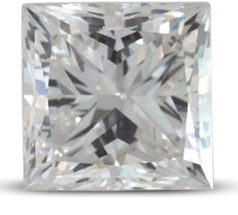
Colour G – A great blend of white colour and value:
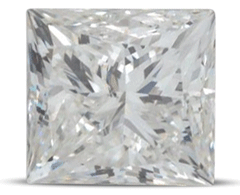
Colour J – Warm tones are much more visible:

Princess cut diamond clarity
As long as you clear a minimum point, clarity is the least important of the 4Cs.
However, it’s often the 4Cs that jewelers make the biggest deal about.
It’s easy to demonstrate clarity in a stone with a jeweler’s loupe (eyeglass) or microscope and show the difference between a VVS1 diamond and a VS2. However, in the real world these stone will look exactly the same and the other Cs (particularly cut) will have a far, far bigger effect on how dazzling your stone is.
For clarity on a Princess cut engagement ring, I recommend going with Vs2 for most stones. For larger princess cut diamonds, VS1 can be a good idea.

Princess cut diamond carat
Understandably, carat weight is one of the key factors that most people consider when buying their ring. It’s the ‘C’ that you are most likely to get asked about, which means that some people prioritise if over other attributes of the diamond which actually make more of a visible difference to what the diamond looks like.
One thing to know is that carat is a measure of weight, rather than size. This distinction is important because an increase in carat weight doesn’t necessarily translate to an obvious increase in visible size.
The images below show the difference in size for Princess cut diamonds at a range of carat weights:
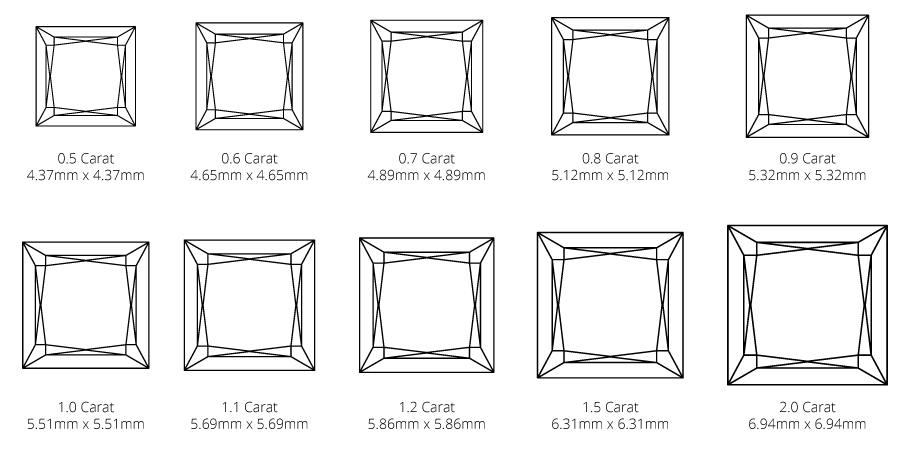
Hopefully you can see that increasing the carat weight doesn’t necessarily translate into a much visibly larger diamond.
Changing the size from 0.8 carat to 1 carat is an increase in width of less than 0.4mm – less than 10%. However, the difference in price will be much more significant – over a 50% increase.
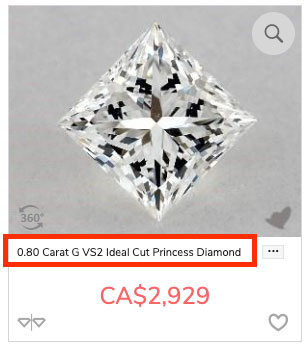
See today’s prices for a 0.8 carat Princess cut diamond here
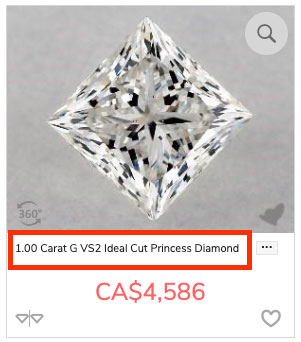
Compare to prices for 1 carat Princess cut diamonds
The priority that you place on diamond carat weight is a personal choice – the aim of this page is to ensure that you make as informed a choice as possible.
My personal opinion is that a diamond with a good balance of factors that delivers great sparkle is more impressive than a diamond with a slightly larger carat weight but obvious flaws e.g. an easily visible inclusion.
Princess cut diamond certification
A diamond’s ‘certificate’ is a document that records its physical attributes – the carat, colour, clarity and a host of other factors:

Diamond certificates are what makes buying online safe. They make it easy to compare diamonds even from different retailers, as you know that each stone’s quality has been graded by an expert.
The lab I most commonly recommend is the non-profit Gemological Institute of America (GIA). It’s the most internationally recognised and generally seen as the most impartial of all of the gem labs.
The reason that the GIA is so well-respected is because many others labs are part of trade bodies that contain jewelry retailers, or are ‘for profit’. While the GIA is very consistent with its gradings, the others have a reputation for being overly generous, which means that you could be paying a premium for an average diamond.
AGS Certificates and princess cut diamonds
Another trustworthy lab for Princess cut diamonds is ‘American Gem Society’, or AGS.
In the section on ‘diamond cut’, I said that princess cut diamonds weren’t assigned a cut quality grade. This isn’t 100% quite true as AGS does have a cut grade for princess cuts, but diamonds graded by AGS can be difficult to find.
The AGS’s grading scale for Princess cut diamonds runs from 0-10, with 0 being the very best cut and 10 being the worst:

Although they are more difficult to find than GIA-certified stones, if you do find an AGS-certified stone then it will take a lot of the guesswork out of buying your Princess cut diamond. Only around 2% of stones are graded at the top level -0. However, these stones have ‘ideal’ proportions and will sparkle beautifully.
Princess cut diamond choice
An important part of buying a princess cut diamond is being able to find the stone that is right for you.
While in this post I’ve made recommendations on specs etc, ultimately buying a diamond is a personal decision. You might decide to go higher on clarity but lower on colour, and that’s OK.
Buying from most Canadian retailers means that you aren’t given the choice of reviewing a large quantity of princess cut diamonds which means that you are forced to choose from the stones that they present to you.
This is another reason I recommend looking online. Not only are you able to take advantage of the lower prices, but you can also search through thousands of diamonds until you find the one that is right for you:

And while thousands of diamonds may seem intimidating, using the filters in the search results will reduce this very quickly to a manageable number to choose from.
Recommended specs
Throughout this page I’ve made recommendations for the specifications of a princess cut diamond that strikes a good balance between beauty and value.
These are a good set of parameters to input into an online retailer’s search tool or to ask a jeweler for.
Or, you can click below to search the recommended specs on James Allen:
Clarity: VS2
Colour: G
Cut: AGS Ideal
Table %: 66% – 75%
Depth %:66% – 75%
L/W ratio:1.00 – 1.05
Certificate: GIA or AGS
